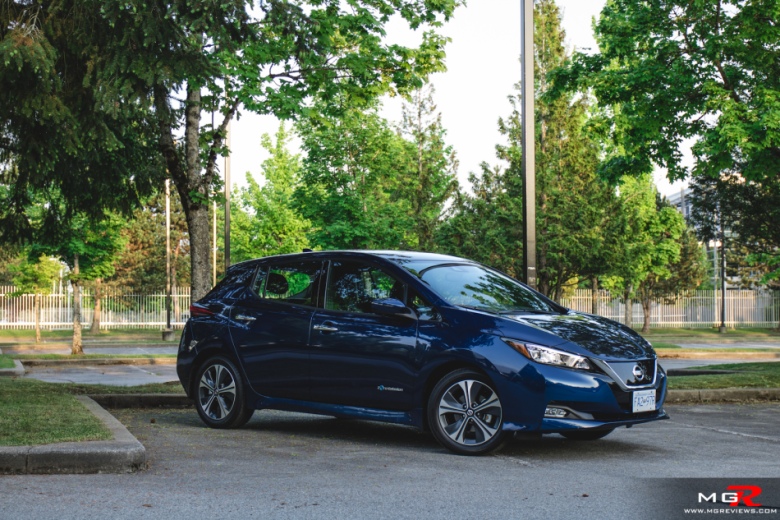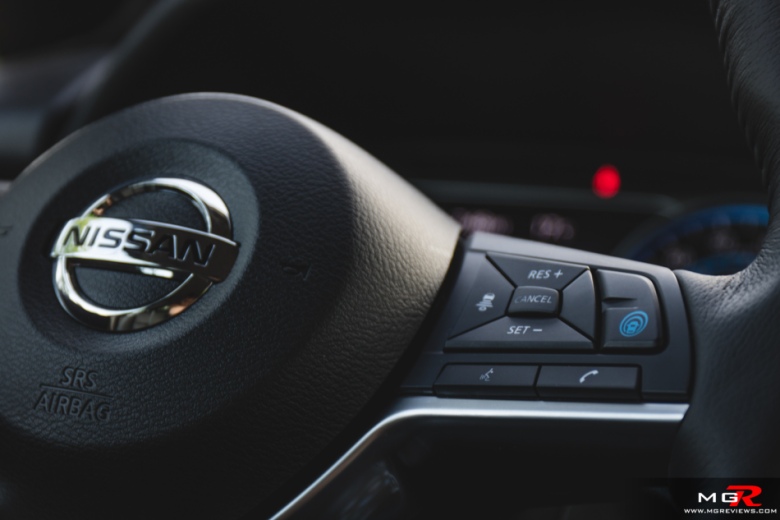The original Nissan Leaf was among the first fully electric, long range vehicles to hit the market. Well when i say “long range” really I mean more than 40km between charges. But now Nissan has introduced a new and much better looking Leaf with nearly double the range of the original.
Performance
Engine – Driving the Nissan Leaf is a 147hp and 240 lb-ft of torque electric motor. That torque figure is instantaneous and it helps the Leaf achieve a 0-100km/h sprint in around 7 seconds which is a lot better than the previous generation of around 10 seconds. Driving around a city, an electric car like the Leaf has become one of the best ways to get around. Instant response from the electric motor and no gasoline goes to waste when stuck in rush hour traffic.
Batteries & Charging – The Nissan Leaf is equipped with a 40 kWh Lithium-Ion battery pack that is situated underneath the floor. Like the Chevrolet Bolt, it can be charged via a 120V outlet, 240V charging station, or a DC fast charge station. Charging from a standard wall outlet at 120V will take a little over a day to fully charge. A 240V charging station (or home outlet) will cut charging time to just 7.5 hours. And a DC fast charge station will get the job done in a little over an hour. A charging cable comes standard with the Leaf but unlike other cables provided by other manufacturers, this one also has an adapter for a 240V home outlet so you don’t have to get a 240V charging station installed in your garage.
Transmission – Like many other full electric vehicles, it doesn’t have one. Power gets sent directly to the wheels via a differential.
Brakes – Braking in the 2018 Nissan Leaf can be done one of two ways. First is the traditional way by pressing on the brake pedal and the car will determine how much regenerative braking and/or physical disc pressure to apply. Secondly is a new feature for Nissan called the e-pedal. Engage the system and regenerative braking becomes much more aggressive to the point where you drive the car by just modulating the accelerator pedal. It takes some getting use to at first but the system works perfectly. Just be aware that in an emergency, you still have to depress the brake pedal.
Handling – While having the heavy batteries as low as possible to improve the center of gravity, the Nissan Leaf is no sports car. It tips the scales at around 1,600 kg and the skinny, eco-friendly tires provide very little grip for any sort of spirited drives through twisty roads. Although the electronic steering is precise, it doesn’t provide any feedback and has the same vague feeling whether it’s pointing straight or turning. The Nissan Leaf feels most at home on city streets.
Related Articles
Comfort
Ride Comfort – The suspension on the Nissan Leaf is soft and meant to absorb potholes and bumps that one may encounter on city streets. It’s not so soft that it gives the feeling of floating over bumps, but it is a bit on the softer side. The seats are equally as comfortable but I find that they are a bit too high up. Due to the battery pack being under the floor, the seats do not go low enough so taller drivers may feel their hair brushing against the headliner.
Noise, Vibration, & Harshness – It’s an electric vehicle so there is no sound from the engine compartment that intrudes into the cabin. On highways there is a little bit of noise coming from the wind rushing past the side mirrors but it’s not overly obtrusive in the cabin. Build quality is equally as good as nothing squeaks or rattles over bumps.
Interior Design – The interior design of the Leaf is nothing revolutionary looking. Most of the controls are where you’d expect them to be and some are taken out of other Nissan vehicles. The only interesting and quirky feature of the interior is the gear selector. It is oddly shaped and it has its own diagram on how to use it. The materials used in the cabin are what one would expect from a mid $30,000 CAD vehicle with plush leather on the seats and plastics everywhere else.
Odds and Ends
Gadgets – The Leaf is available with features that are found in other Nissan vehicles. Navigation, Apple CarPlay and Android Auto, heated seats, keyless entry and go, etc. are all available on the Leaf. It is also available with emergency automatic braking, lane keeping aid, blind spot sensors, and emergency automatic braking. These features can be turned on or off at the push of just one button on the steering wheel. The blue ProPilot assist button is similar to that of Volvo’s Pilot Assist system in which it maintains a set speed to the car in front and steers around gentle corners on a highway.
Exterior Design – In addition to the longer driving range, the exterior design of the Nissan Leaf is the second biggest improvement over the previous generation. It’s much more edgy and contemporary looking. I especially like the “3D” looking design on the charge port flap.
With a starting price of $36,398 CAD, the 2018 Nissan Leaf is substantially less expensive than the Chevrolet Bolt. It may not come with as many standard features and have a shorter driving range but for someone looking for a city car that uses no gas, it’s a very good choice.
Thank you to Nissan Canada for providing the vehicle. www.Nissan.ca








